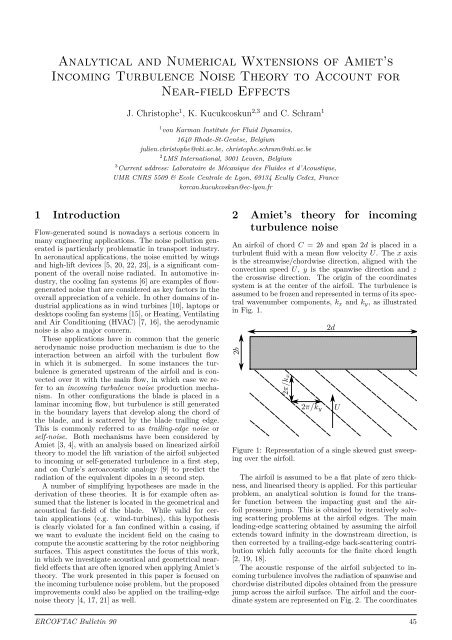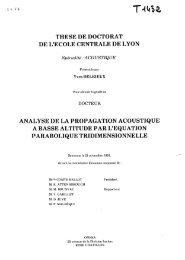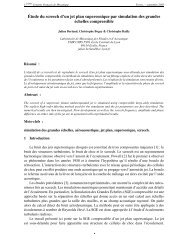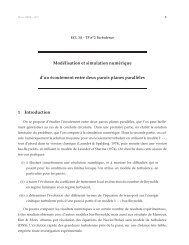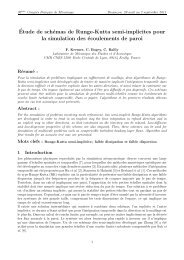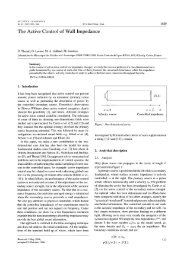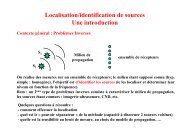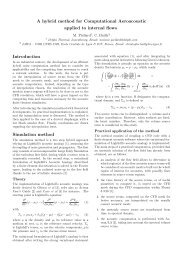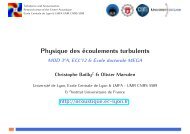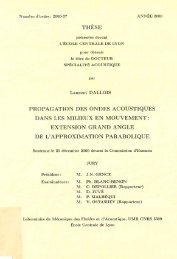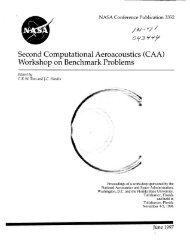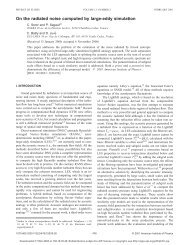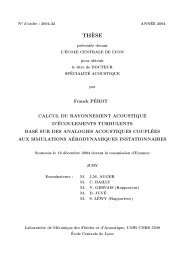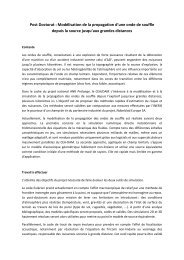ERCOFTAC Bulletin - Centre Acoustique
ERCOFTAC Bulletin - Centre Acoustique
ERCOFTAC Bulletin - Centre Acoustique
Create successful ePaper yourself
Turn your PDF publications into a flip-book with our unique Google optimized e-Paper software.
Analytical and Numerical Wxtensions of Amiet’s<br />
Incoming Turbulence Noise Theory to Account for<br />
Near-field Effects<br />
1 Introduction<br />
J. Christophe 1 , K. Kucukcoskun 2,3 and C. Schram 1<br />
1<br />
von Karman Institute for Fluid Dynamics,<br />
1640 Rhode-St-Genèse, Belgium<br />
julien.christophe@vki.ac.be, christophe.schram@vki.ac.be<br />
2<br />
LMS International, 3001 Leuven, Belgium<br />
3<br />
Current address: Laboratoire de Mécanique des Fluides et d’<strong>Acoustique</strong>,<br />
UMR CNRS 5509 & Ecole Centrale de Lyon, 69134 Ecully Cedex, France<br />
korcan.kucukcoskun@ec-lyon.fr<br />
Flow-generated sound is nowadays a serious concern in<br />
many engineering applications. The noise pollution generated<br />
is particularly problematic in transport industry.<br />
In aeronautical applications, the noise emitted by wings<br />
and high-lift devices [5, 20, 22, 23], is a significant component<br />
of the overall noise radiated. In automotive industry,<br />
the cooling fan systems [6] are examples of flowgenerated<br />
noise that are considered as key factors in the<br />
overall appreciation of a vehicle. In other domains of industrial<br />
applications as in wind turbines [10], laptops or<br />
desktops cooling fan systems [15], or Heating, Ventilating<br />
and Air Conditioning (HVAC) [7, 16], the aerodynamic<br />
noise is also a major concern.<br />
These applications have in common that the generic<br />
aerodynamic noise production mechanism is due to the<br />
interaction between an airfoil with the turbulent flow<br />
in which it is submerged. In some instances the turbulence<br />
is generated upstream of the airfoil and is convected<br />
over it with the main flow, in which case we refer<br />
to an incoming turbulence noise production mechanism.<br />
In other configurations the blade is placed in a<br />
laminar incoming flow, but turbulence is still generated<br />
in the boundary layers that develop along the chord of<br />
the blade, and is scattered by the blade trailing edge.<br />
This is commonly referred to as trailing-edge noise or<br />
self-noise. Both mechanisms have been considered by<br />
Amiet [3, 4], with an analysis based on linearized airfoil<br />
theory to model the lift variation of the airfoil subjected<br />
to incoming or self-generated turbulence in a first step,<br />
and on Curle’s aeroacoustic analogy [9] to predict the<br />
radiation of the equivalent dipoles in a second step.<br />
A number of simplifying hypotheses are made in the<br />
derivation of these theories. It is for example often assumed<br />
that the listener is located in the geometrical and<br />
acoustical far-field of the blade. While valid for certain<br />
applications (e.g. wind-turbines), this hypothesis<br />
is clearly violated for a fan confined within a casing, if<br />
we want to evaluate the incident field on the casing to<br />
compute the acoustic scattering by the rotor neighboring<br />
surfaces. This aspect constitutes the focus of this work,<br />
in which we investigate acoustical and geometrical nearfield<br />
effects that are often ignored when applying Amiet’s<br />
theory. The work presented in this paper is focused on<br />
the incoming turbulence noise problem, but the proposed<br />
improvements could also be applied on the trailing-edge<br />
noise theory [4, 17, 21] as well.<br />
2 Amiet’s theory for incoming<br />
turbulence noise<br />
An airfoil of chord C = 2b and span 2d is placed in a<br />
turbulent fluid with a mean flow velocity U. The x axis<br />
is the streamwise/chordwise direction, aligned with the<br />
convection speed U, y is the spanwise direction and z<br />
the crosswise direction. The origin of the coordinates<br />
system is at the center of the airfoil. The turbulence is<br />
assumed to be frozen and represented in terms of its spectral<br />
wavenumber components, kx and ky, as illustrated<br />
in Fig. 1.<br />
Figure 1: Representation of a single skewed gust sweeping<br />
over the airfoil.<br />
The airfoil is assumed to be a flat plate of zero thickness,<br />
and linearised theory is applied. For this particular<br />
problem, an analytical solution is found for the transfer<br />
function between the impacting gust and the airfoil<br />
pressure jump. This is obtained by iteratively solving<br />
scattering problems at the airfoil edges. The main<br />
leading-edge scattering obtained by assuming the airfoil<br />
extends toward infinity in the downstream direction, is<br />
then corrected by a trailing-edge back-scattering contribution<br />
which fully accounts for the finite chord length<br />
[2, 19, 18].<br />
The acoustic response of the airfoil subjected to incoming<br />
turbulence involves the radiation of spanwise and<br />
chordwise distributed dipoles obtained from the pressure<br />
jump across the airfoil surface. The airfoil and the coordinate<br />
system are represented on Fig. 2. The coordinates<br />
<strong>ERCOFTAC</strong> <strong>Bulletin</strong> 90 45


